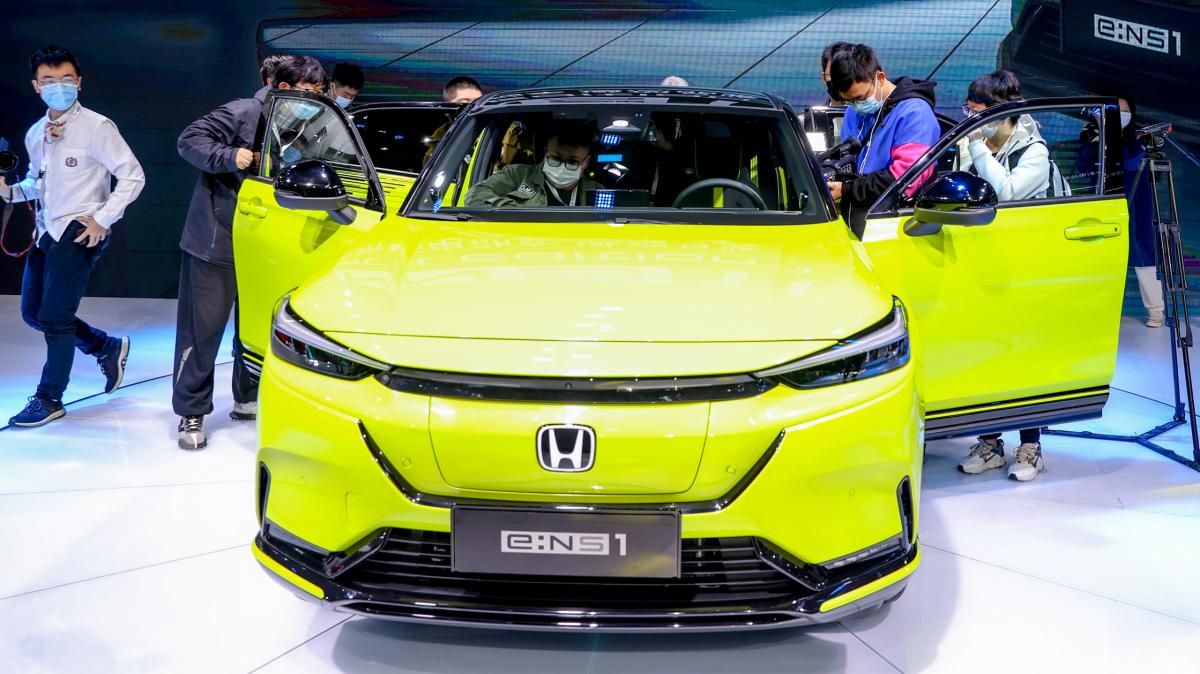“Swallow” the market in the next 10 years?
Honda to launch 30 electric car models by 2030
Japan’s Honda Motor Co Ltd plans to spend $64 billion on electric vehicle research and development over the next decade, setting an ambitious goal of launching 30 electric vehicle models globally by 2030. Their goals include producing about 2 million electric vehicles a year by 2030, aiming to gain share in the fast-growing electric vehicle market, led by Tesla Inc, while Japanese automakers have risk falling behind its European and American rivals.

This strategy marks a boost for Honda to gain a foothold in the fast-growing electric vehicle market. Photo: @AFP.
“Over the next 10 years, we will invest about 8 trillion yen ($64 billion) in research and development costs for electric vehicles,” said Honda CEO Toshihiro Mibe. set up a dedicated electric vehicle production line in North America, where it will also buy Ultium batteries from General Motors, which is also considering a separate joint venture to manufacture batteries there, in addition to the partnership with GM.
Last week, Honda said that it and GM will develop a range of cheaper electric vehicles based on a new common platform, expanding on GM’s plan to begin production of two electric SUVs for Honda starting in 2024. As you can see, the development of electric vehicles has prompted Honda to find partners to optimize costs and share technology.
“This gives them a good relationship with a lot of other manufacturers in battery technology … which will eventually leave the internal combustion engine behind,” said Christopher Richter, an analyst at CLSA.
“Given their size, I’m glad they’re partnering with General Motors,” Christopher Richter said.
Most of the 8 trillion yen investment is devoted to electrification and software engineering. That includes about 43 billion yen for the solid-state battery production line, which is scheduled to start in spring 2024.
Continue to strengthen the business and reduce costs
Honda says the effort is to help them realize “the joy and freedom of movement” by seeking to be “environmentally sustainable”. It wants to be carbon neutral by 2050 and for this Honda will include the use of replaceable batteries and hydrogen, as well as the electrification of cars. Honda believes this will provide different solutions for all of its products, depending on how customers use their products in different countries and regions.
Honda said it has also made some organizational changes to strengthen its electrification business. Honda’s entire business is currently divided into motorcycles, automobiles, and electrical products. They have incorporated the technology areas under the newly launched Business Development Activity.
The announcement also reveals that in 2026, Honda will begin to apply Honda e: Architecture, an EV platform that combines a hardware platform and a software platform.
Kohei Takeuchi, Executive Vice President of Honda, said that Honda will also rely on external funding methods when necessary. Last month, Honda said it would issue a $2.75 billion USD-denominated Green Bond, which will be allocated to the development and production of zero-emission vehicles.
Hybrid cars are still important weapons, even electric cars shine
Honda and other Japanese automakers have long said that, even if they go electric, they won’t abandon older hybrid technology. Hybrid car advocates point to many markets, especially in emerging countries, where the infrastructure to support battery electric vehicles will be far from developed.
“It doesn’t mean this is the end of hybrids or that all hybrids have to be replaced by EVs,” Mibe said during the presentation. “We will develop existing hybrid models and use them as a weapon in our business.”

Honda also said it plans to produce about 2 million electric vehicles a year by 2030. Much of the investment will be in electrification and software technology, Honda said. Photo: @AFP.
Analyst Seiji Sugiura of Tokai Research Institute Tokyo said that Honda’s plan to produce 2 million EVs a year has come within expectations. This is because Toyota Motor Corp has set a sales target of 3.5 million such vehicles by 2030, and Nissan has targeted half of its vehicles to be electric by the end of the decade.
Aim for electric vehicles to account for 100% of sales by 2040
Previously, in April 2021, CEO Toshihiro Mibe said that Honda aims to make up 100% of its sales for electric vehicles by 2040. Speaking at the first press conference since taking the helm of the house. Japan’s second-largest carmaker in early April last year, Mibe said the company supports the government’s green goals.
“I believe it’s the responsibility of an automaker to achieve zero carbon,” Mibe said. The company expects EVs to account for 40% of sales by 2030 and 80% by 2035 and 100% by 2040 in all key markets, including North America and China.
Honda’s announcement of its electrification strategy comes after Prime Minister Yoshihide Suga announced that Japan will aim to cut emissions by 46 percent by 2030 and look to go even further, nearly doubling it. with the previous goal.
The goal set by the government is “achievable,” Mibe said. “Although the government’s target is extremely difficult, I believe it is a achievable target from the perspective of Japan becoming carbon neutral by 2050,” he said.
at Blogtuan.info – Source: danviet.vn – Read the original article here

